| |
|
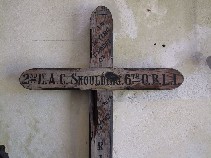 |
|
Knowing, as you
might, that Melton is an industrial
suburb of Woodbridge, you will perhaps
expect an urban setting, and a church
greatly enlarged by the Victorians. But
this is entirely not the case. Instead,
you leave the village on the road to Wickham
Market, and take the
turning down into Ufford,
and the river valley.
After travelling through
woodland and meadows for a mile or so,
and shortly before you reach that pretty
village, you come across the old church
of St Andrew, sitting in a wide, open
graveyard.
Here are graves in
abundance, and modern ones too, for all
Melton still comes here to be buried; but
St Andrew is tiny, and you will be
further surprised to learn that it has
not been used as a parish church for more
than a century.
|
When
the railway reached Melton, so did the jobs. The
village expanded rapidly. Rather than spend a
fortune on a necessary expansion of their remote
church, the Victorians did a thing which was
unusual in Suffolk: they built a completely new one, up in the
main village. New St
Andrew (confusingly, the dedications are
the same) is much larger, but its site did not
allow room for burials.
So,
this old church remained in use as a mortuary
chapel, until well into the 1970s. To make it
more suitable for its new role, the Victorians
demolished the chancel, replacing it with an
apse. They blocked up the north and south doors,
opening up the west door to allow funeral biers
access.
After
being officially declared redundant in 1977, all
sorts of new uses were suggested. Planning
permission was granted for its conversion into a
study centre, with the installation of a
mezzanine floor and roof windows. This would, I
have no doubt, have been a sensible use, but
there are more important things than pragmatism:
loyalty and love, for instance. The people of
Melton did not want to lose their church. And so,
in 1982, they bought it off of the church
commissioners for several thousand pounds. Today,
they maintain it as a charitable trust.
The
church is kept locked, sadly, but is opened
several times a year, for the Melton Old Church
Society hold regular events here. In addition,
Evensong is celebrated on All Souls Day,
appropriately enough for a former mortuary
chapel, and there is an annual carol service.
You
step inside, and your first sight is of an array
of World War I crosses. There are apparently nine
of them. They are all different, some of them
painted and some of them with stamped aluminium
tags. Two of them tell us that the person
remembered died of wounds.
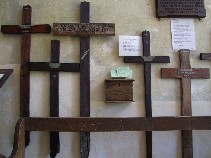 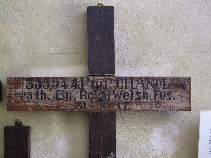 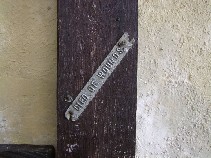 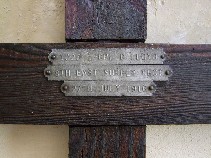
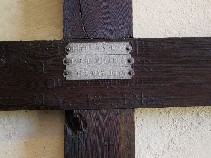 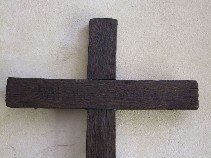 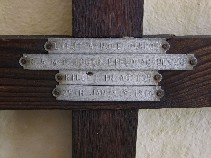 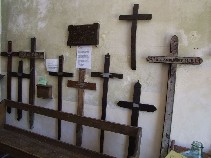
Those
remembered include Alfred Cecil Skoulding, a
Second Lieutenant in the Oxford and Bucks Light
Infantry, who died on the 21st February 1917. He
was 33 years old. He was the son of Mrs SM Skoulding, of The
Rosary, Melton, and he is buried in Meaulte
Cemetery on the Somme.
Another is for Percy
Chandler, a Private in the Royal Welsh Fusiliers.
He was 27 when he died on the 31st October 1917.
he was the son of George and Annie Chandler, of
Pine View, Melton Rd., Woodbridge, but he lies
today far from home in the Beersheba War Cemetery
in modern Israel.
A third is to Charles
Lloyd, a Lance Corporal in the 8th Batallion of
the East Surrey Regiment. He died on the 27th
July 1917 when he was 23 years old. He was the
son of Henry and Eliza Lloyd, of Wilford Place,
Melton. He is buried in Rouen, which suggests
that he died of wounds at a hospital behind the
lines, and was almost certainly injured during
the first days of the Battle of the Somme.
There are three Garrods
remembered here. They were the sons of Colonel
SIr Archibald Garrod KCMG, Regius Professor of
Medicine at Oxford, and his wife Laura. Alfred
Noel Garrod (recorded as 'Noll' on his cross) was
a Doctor himself, aged 28 when he was killed
serving as a Lieutenant in the Royal Army Medical
Corps at the age of 28 on the 25th January 1916.
He is buried in Bethune town cemetery in
Flanders. His younger brother Thomas Martin
Garrod had been just 20 years old when he was
killed seven months earlier while serving as a
Lieutenant in the 1st Loyal North Lancashire
Regiment. He is also buried in Bethune town
cemetery. A third brother, Basil Rahere Garrod,
died after the war in Cologne, Germany, his cross
noticeably different to the others, and all three
are also remembered on a plaque in the new St
Andrew.
Peter Ungerer is remembered
on another cross. He was 35 years old when he was
killed on the 9th July 1917 during the Third
Battle of Ypres. He was the husband of Edith
Ungerer, of Toll Gate Cottages, Melton, and lies
now in Gwalia Cemetery in Belgium. William Thomas
Woolnough, the cross beside his, fought as a
Corporal with East Ontario Regiment of the
Canadian Infantry, but was killed at the age of
31 on the 25th April 1915. He was the son of Mrs
H Woolnough of Melton. He lies today at Mont
St-Eloi just outside of Ypres.
I
said that there are apparently nine, because the
last one of them is not a WWI cross at all. This
is the simple wooden marker at the top to Daisy
Nunn. Almost certainly, this was rescued from the
graveyard outside the church. It is slightly
older than the WWI crosses, and it probably
marked the last resting place of the Daisy Nunn
who died shortly after birth in the Woodbridge
registration district during the first quarter of
1896.
These wooden crosses were
temporary markers, originally used on the
battlefield to mark the places where the dead
lay. In the 1920s, they were replaced with
permanent stone markers, and the thousands of
wooden crosses were made available for families
who requested them. Many ended up in parish
churches, from where, over the decades, many have
disappeared or simply been discarded.
You
often come across individual survivals in
Suffolk, and there are seven at the otherwise
unremarkable church at Leavenheath, but no other
church in East Anglia has a collection so big.
On
the north side of the nave is a stunning brass,
featuring a Priest, and what appears to be his
parents. The inscriptions and heraldry are
completely destroyed, as is much of the
decoration, although this is as likely to be the
work of 18th and 19th century collectors, vandals
and thieves as anything to do with 16th and 17th
century iconoclasm.
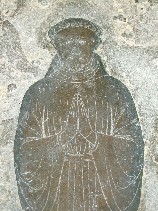 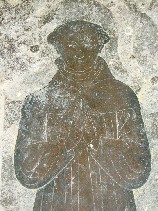 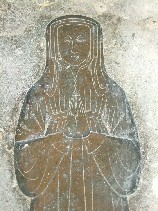
Melton worthies of a later,
gentler age are remembered around the walls.
Among them are Searles Valentine Wood, who was the
author of a work on the Mollusca of the Crag,
and died in 1880, and his wife. Their tablet was
placed here by their only child, who was
also called Searles Valentine Wood, and who died
himself just four years later at the age of 54.
His is the tablet above, which notes that he was
the first geologist to undertake the detailed
mapping over an extensive area of the various
sub-divisions of the sub-glacial drift, a task of
infinite labour and of great practical and
scientific importance. The inscription is in
a curious oriental style which must have been
fashionable at the time, but which I do not think
I have seen elsewhere. Opposite, William Negus
was the son of Francis Negus, a former MP for
Ipswich. The inscription tells us rather
poignantly that the younger Negus, although
educated in a court... preferred the more private
station of a country Gentleman, in which he lived
beloved and esteemed, and died lamented.
| A stand-alone 19th century
altar-cum-reredos sits in the apse.
It was probably intended for simply built
churches out in the Empire. Cunningly
hidden behind it is a doorway into the
kitchen added by the Society in recent
years, to give this remote place running
water for functions. But
the feature which made this church most
remarkable is no longer here. This is one
of Suffolk's 13 seven sacrament fonts,
one of only ten to retain its imagery.
Uniquely, it features the martyrdom of St
Andrew as its eighth panel. You can still
see it - but you will need to travel to
the otherwise unremarkable new
church in the village,
some two miles away. Before you turn
back, though, don't forget that half a
mile in the other direction is the
beautiful church of the
Assumption, Ufford,
with all its famous treasures.
It goes without saying that
the Melton Old Church Society is to be
thoroughly congratulated for the care and
affection they lavish on this little
place. Wouldn't it be great if it could
be open more often!
|
|
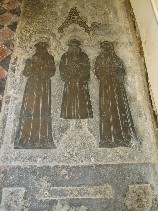 |
|
|
|

